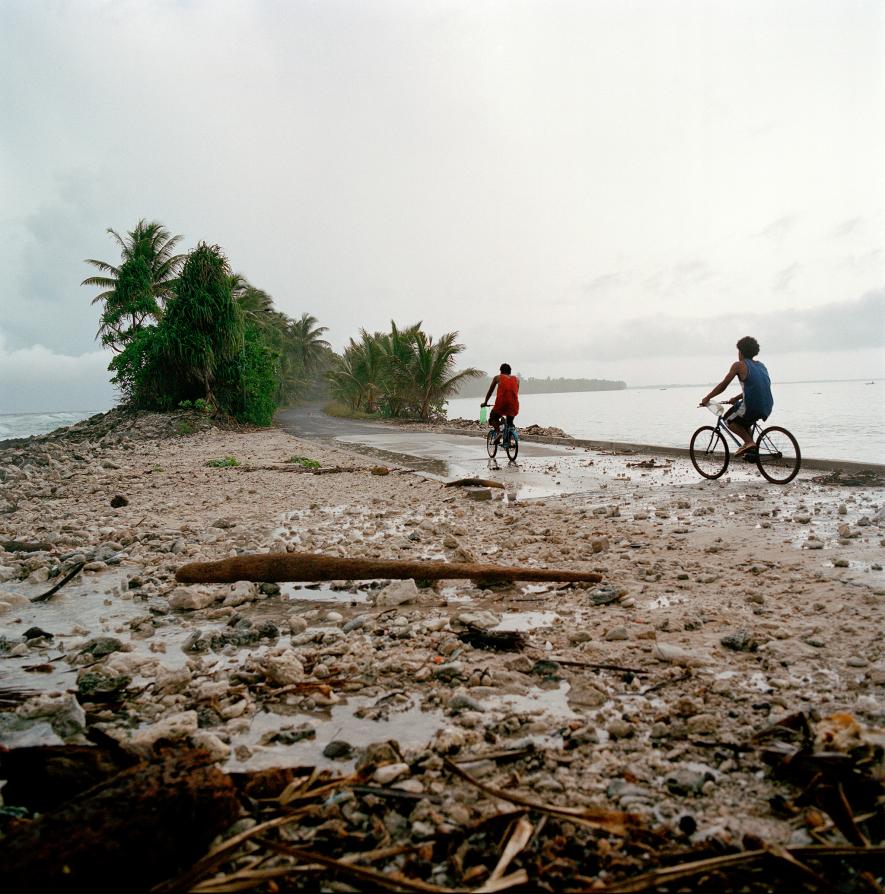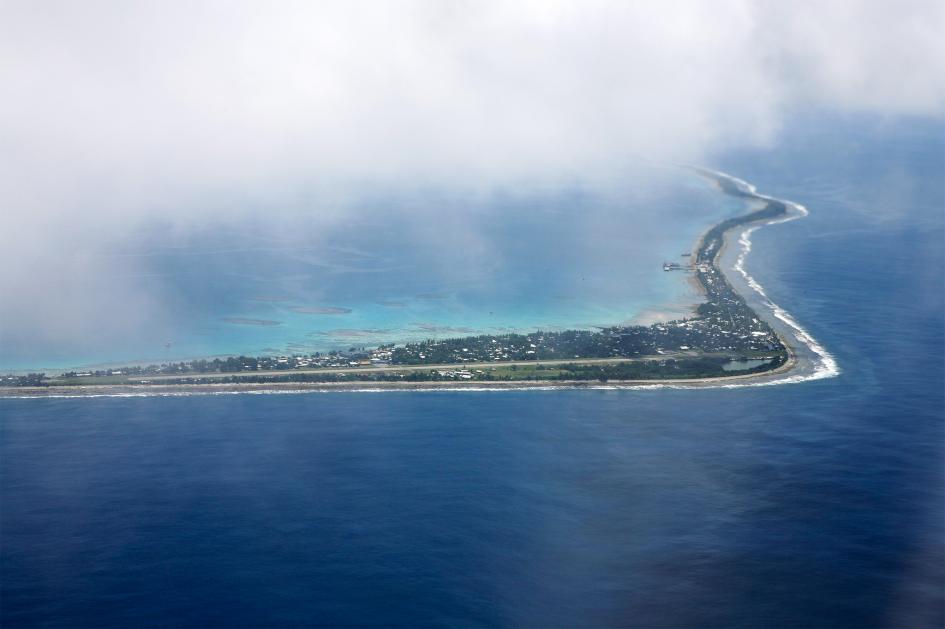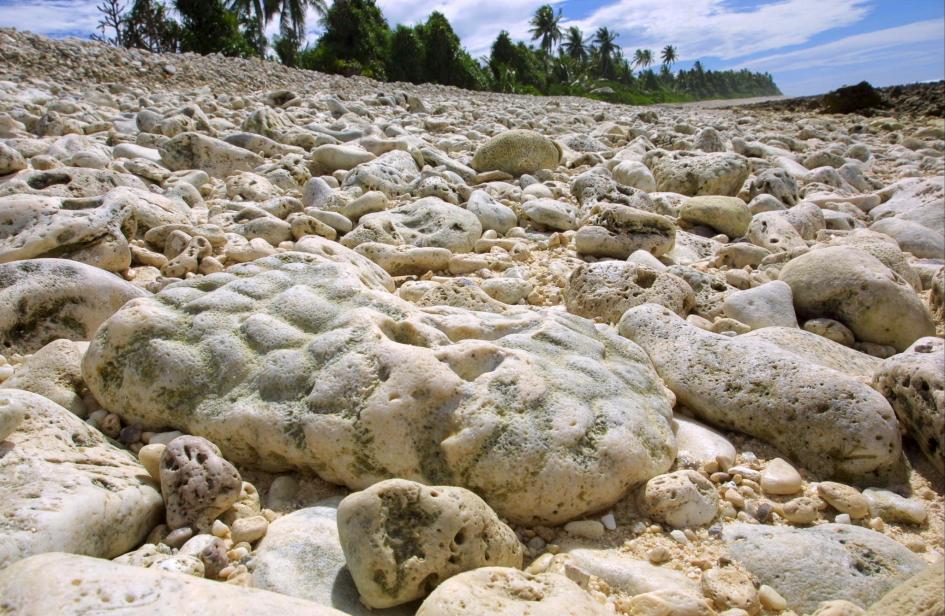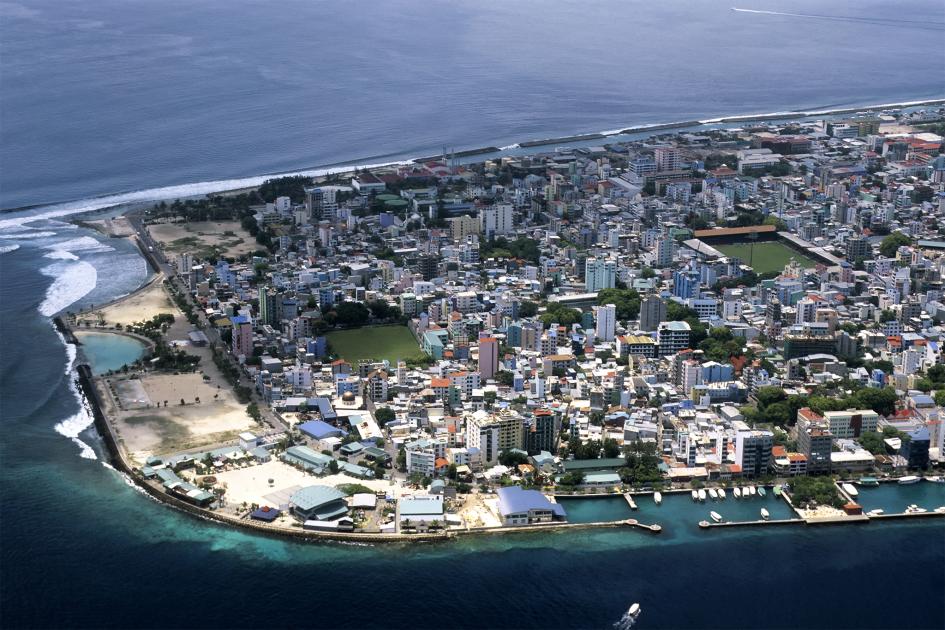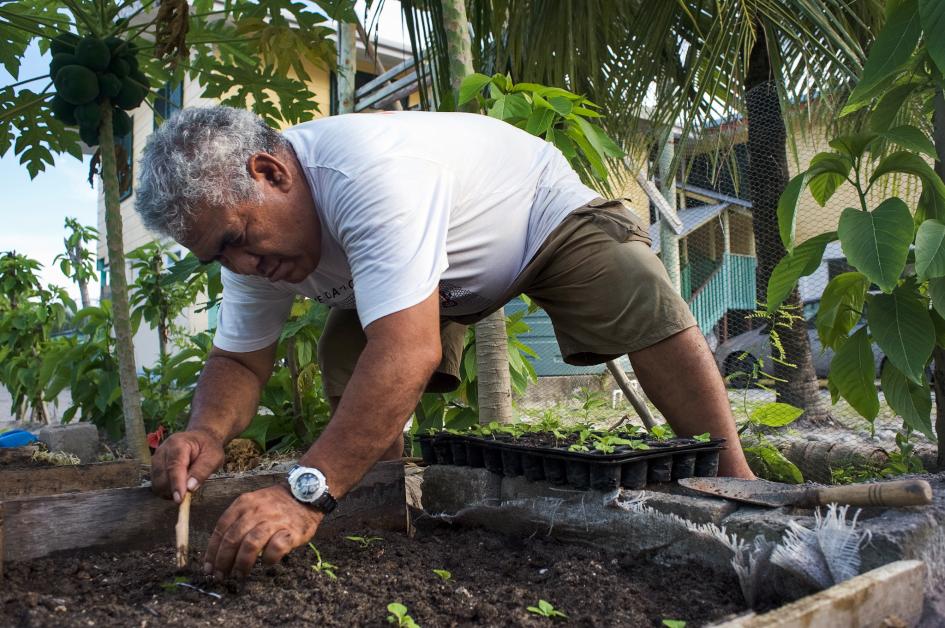
Will Pacific Island Nations Disappear as Seas Rise? Maybe Not
Photograph by Robin Hammond, Panos Pictures
Source:nationalgeographic.com
Reef islands can grow and change shape as sediments shift, studies show.
“If you were faced with the threat of the disappearance of your nation, what would you do?”
That’s the question Enele Sopoaga, the prime minister of the tiny Pacific Island nation of Tuvalu, asked fellow world leaders at the United Nations climate summit in Lima, Peru, in December.
It’s a question that leaders of Pacific Island states have been asking for decades. As a warming climate drives sea levels upward, low-lying island nations face an uncertain future—or no future at all, say these leaders, who warn of their nations’ imminent disappearance.
Officials in Tuvalu, 600 miles (965 kilometers) north of Fiji, have been some of the most vocal critics of the world’s large greenhouse gas emitters—industrialized nations such as the United States and China—which they accuse of not doing enough to curb emissions, contributing to the melting of ice sheets and rising seas.
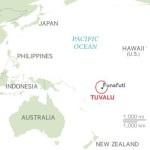
“I carry a huge burden and responsibility,” Sopoaga told the climate summit delegates in Peru. “It keeps me awake at night. Will we survive? Or will we disappear under the sea?”
These are desperate questions. But how real is the threat? Are island nations like Tuvalu, where most of the land is barely above sea level, destined to sink beneath the waves, like modern-day Atlantises?
Not necessarily, according to a growing body of evidence amassed by New Zealand coastal geomorphologist Paul Kench, of the University of Auckland’s School of Environment, and colleagues in Australia and Fiji, who have been studying how reef islands in the Pacific and Indian Oceans respond to rising sea levels.
They found that reef islands change shape and move around in response to shifting sediments, and that many of them are growing in size, not shrinking, as sea level inches upward. The implication is that many islands—especially less developed ones with few permanent structures—may cope with rising seas well into the next century.
But for the areas that have been transformed by human development, such as the capitals of Kiribati, Tuvalu, and Maldives, the future is considerably gloomier. That’s largely because their many structures—seawalls, roads, and water and electricity systems—are locked in place.
Their analysis, which now extends to more than 600 coral reef islands in the Pacific and Indian Oceans, indicates that about 80 percent of the islands have remained stable or increased in size (roughly 40 percent in each category). Only 20 percent have shown the net reduction that’s widely assumed to be a typical island’s fate when sea level rises.
Some islands grew by as much as 14 acres (5.6 hectares) in a single decade, and Tuvalu’s main atoll, Funafuti—33 islands distributed around the rim of a large lagoon—has gained 75 acres (32 hectares) of land during the past 115 years.
Two-thirds of the reef islands in the study migrated lagoon-ward as their ocean-side coastlines eroded and sediment built up on the side facing the lagoon. One of Funafuti’s islands shifted more than 350 feet (106 meters) over 40 years.
Reef islands, Kench says, are among the most dynamic landforms on Earth. And Tuvalu’s are some of the most dynamic on record.
With a scant ten square miles (26 square kilometers) of dry land, Tuvalu is one of the smallest countries in the world. Although there are many atolls and islands in the group, which lies midway between Australia and Hawaii, more than half of Tuvalu’s 12,000 people live on just one island—Fongafale—on the eastern rim of Funafuti atoll.
Business as Usual
I first came to Tuvalu ten years ago, my interest piqued by news reports suggesting (and sometimes stating outright) that the islands were doomed. Journalists had latched on to countries such as Tuvalu, Kiribati, and Maldives as the environmental hard-luck stories of the new millennium.
These postcard paradises had become poster children for a planetary crisis, with their inhabitants cast as the world’s first climate refugees. “Tuvalu Sinks Today—The Rest of Us Tomorrow?” was a typical headline.
A prominent environmental campaigner had declared that Tuvalu’s leaders had “conceded defeat in their battle with the rising sea, announcing that they will abandon their homeland.”
A similar claim was made in Al Gore’s documentary, An Inconvenient Truth.
“The evacuation and shutting down of a nation has begun,” reported the British Guardian newspaper.
That islands like Tuvalu face an intensifying barrage of climate impacts is not in doubt.
Besides the damage inflicted by sea-level rise itself—coastal erosion, surface flooding, and saltwater intrusion into soil and groundwater—they will suffer from increasingly frequent and severe weather extremes (droughts and cyclones) and die-offs of their coral reefs through ocean warming and acidification, leading to potential collapse of marine ecosystems that provide food and livelihoods for island dwellers.
But from what I could see, in 2004 it was business as usual in Funafuti. Government staff were about to move into a brand-new building overlooking the lagoon. The country’s first cell-phone tower had just been erected. Tuvalu was enjoying a windfall profit from the sale of its “dot tv” Internet suffix. Tuvaluans seemed in no hurry to evacuate their supposedly disappearing homeland.
In November 2014, armed with Kench’s findings, I returned to Tuvalu to see whether anything had changed. The first thing I noticed was that Fongafale was even more crowded than before. According to the 2012 census, Fongafale’s population had increased by 1,500 since my earlier visit, to more than 6,000. So much for the shutting down of a nation.
Island Building
I hired a fishing dory and made a spray-drenched trip across Funafuti’s 106-square-mile (275-square-kilometer) lagoon to an uninhabited island called Tepuka. It has the classic appearance of an atoll island: a pancake of sand with a mop of vegetation and, floating above, a confetti of seabirds.
Such islands look static, but they are perpetual construction sites. Their surrounding coral reefs are factories that produce a constant supply of raw building material: calcium carbonate.
The factory “workers” are biological agents that turn the skeletons of corals and other carbonate-containing creatures into sediment. Fish, sea urchins, and sponges are the principal processors. In one year they can produce four pounds of sediment per square foot (21 kilograms per square meter) of reef.
Coral rubble, here washed up on the shores of Fongafale, is the building material of reef islands. It is pulverized by wave action and worked into the substrates of the islands, often causing them to grow in size even as sea levels rise.
Photograph by Patrick Aventurier, Gamma-Rapho/Getty
Mollusks, calcium-secreting algae, and tiny marine creatures called foraminifera add to the sediment supply. Tepuka’s beaches have an orange tinge from billions of foraminifera skeletons.
Geomorphologists, who study landforms, speak of an island’s “carbonate budget”—its sedimentary profit-and-loss account. On the income side of the ledger is the rubble, gravel, and sand produced by the reef ecosystem or imported into it, by storms, for instance. On the expenditure side is sediment lost by being abraded to microscopic fineness, dissolved in seawater, or exported by waves or currents into the deep ocean.
The budget can stay more or less balanced for decades, centuries, even millennia, and then experience a sudden blowout, as when Cyclone Bebe hit Funafuti in 1972. Overnight the storm deposited a 12-mile (19-kilometer) ridge of coral rubble up to 13 feet (4 meters) high.
That material was worked into the matrix of several reef islands on the southeastern side of the atoll—the side that took the brunt of Bebe’s force—increasing the land area by 10 percent.
Tepuka, on the western side, missed out on the Bebe deposit and is one of a handful of Funafuti’s islands that have been shrinking. On the ocean side of the island, a three-foot-high (one meter) scarp of sandy soil up against the vegetation showed where wave action was scouring away the land.
I’d seen this kind of erosion on island coastlines elsewhere in the world and had assumed it was evidence of irreversible loss. But Kench’s work offers a different narrative: abrasion on one side of an island, accretion on the other, with entire islands shifting on their reef platforms in response to wind, waves, and sea-level change.
Yes, islands erode, Kench says, and that’s often what people focus on: broad beaches where they used to play soccer as kids now reduced to a narrow patch of sand. Or perhaps the edge of a property crumbling into the sea. Or a family grave undermined by the tide.
“But they often forget to look at the other sides of the islands, where beaches are growing,” Kench adds.
In Tepuka’s case, a net loss in area of 22 percent since 1896 is only part of the story. The island has undergone an almost constant reworking of its sedimentary material during the past century. It’s grown longer (by 550 feet, or 170 meters) and narrower (by 390 feet, or 120 meters), and its position has rotated clockwise on the reef.
 Tuvalu’s government buildings stand on the western shore of Fongafale, overlooking Funafuti lagoon. Permanent structures such as buildings, roads, and electricity networks make it hard for developed islands to adapt to the dynamic changes in shape and size that reef islands undergo.
Tuvalu’s government buildings stand on the western shore of Fongafale, overlooking Funafuti lagoon. Permanent structures such as buildings, roads, and electricity networks make it hard for developed islands to adapt to the dynamic changes in shape and size that reef islands undergo.
Photograph by Jocelyn Carlin, Panos Pictures
Although it’s shrinking now, a big-enough storm could push Tepuka’s sediment budget back into the black. It’s happened before. Geological surveys across the island have shown that at times, large sections have been washed over by the sea, with tons of sediment deposited on top of the existing vegetation.
The lesson of Tepuka, Kench says, is that it’s important to focus on what sediment is doing and not just on sea level.
Rising Seas Don’t Equal Sinking Islands
Tepuka is very young, having formed 500 to 1,000 years ago. Polynesians—whose occupation of the islands is thought to go back more than 2,000 years—might well have watched it grow.
Tepuka’s young age, says Kench, places its formation within a period of stable global sea level—which runs counter to the idea that reef islands can form only when falling sea levels trigger the processes of island building.
Other work by Kench shows that such islands can form even when sea level is rising rapidly.
His analysis of the sediments on Jabat, in the Marshall Islands, indicates that the island started forming nearly 5,000 years ago, when the oceans were rising to a peak of more than three feet (one meter) higher than today’s sea level—a point that is likely to be reached again, or exceeded, by the end of this century, according to predictions by the International Panel on Climate Change.
High-energy storm action built Jabat—the very condition that’s forecast to occur with greater frequency as the planet’s atmosphere warms.
Kench’s findings suggest that rising sea levels today might reactivate processes of island building that have long been relatively dormant.
“If sea-level rise does ramp up to the levels they’re talking about,” Kench says, “I would expect islands to start showing increased rates of change. The faster sea level goes up, the more dynamic these islands are going to appear.”
Reef Loss, Island Gain
Some climate specialists believe that rising sea-surface temperatures and increasing ocean acidity may have an even more damaging impact on coral reefs than that caused by sea-level rise.
Since the beginning of the industrial period, some 250 years ago, the acidity of tropical surface waters has risen by 30 percent. Sea-surface temperatures have increased by about 1.8°F (1°C) during the past century.
High water temperatures kill corals, and acidification affects their ability to produce their skeletons, since calcium carbonate dissolves in acid. Laboratory experiments suggest that the calcification rate of some corals could decrease by a third over the next three to five decades.
Yet a reef’s loss of living coral can be an island’s gain—at least in the short term. In 1998, when a worldwide coral bleaching event killed up to one-sixth of the world’s reefs, a huge repository of coral rubble became available for island building. If heat-related coral die-offs occur in coming decades, the sediment supply for islands is likely to increase.
But Kench cautions that scientists don’t yet have a clear understanding of how changes in ocean chemistry will affect coral reefs, or how that might translate to islands. “We don’t have a good handle on the time lag between when coral is killed and when it becomes available to an island as sand,” he says.
Over the time scales that matter to island nations—the next few decades when they’ll be seeking to adapt to land changes—the critical factor, Kench says, is the reworking of sands and gravels around the reef islands. “And that’s controlled by wave processes and whether there’s sediment available. If sand is still being produced, islands are able to adjust and maintain their area.”
For Urban Islands, an Uphill Battle
“Urban islands are in trouble because they’ve lost their capacity to adapt,” Kench says. “They’re environmentally degraded. Their reefs are damaged, the sedimentation processes are undermined, and the islands aren’t actively connected to their reefs. For densely urban centers, the only strategies to cope with rising sea levels will be engineered ones.”
Malé, the capital of Maldives—a 1,200-atoll archipelago in the Indian Ocean, and one of the countries predicted to be most affected by climate change and rising seas—is such an island. It’s encircled by built structures such as seawalls, breakwaters, harbors, and artificial beaches.
“Heavily fortified,” is how Mohamed Aslam, an oceanographer by training and until 2012 the environment minister for Maldives, described it to me.
“There’s no room for natural processes to take place,” he says. “I suppose if you spent enough money, you could continue to keep the sea out. But it’s prohibitively expensive for a country with a small population and a small GDP to do that sort of thing on every island.”
Saltwater intrusion into soils makes horticulture challenging on Tuvalu’s nine island groups. Gardeners like Kitiona Tausi, above, try various methods to raise their plant beds above the salination level. On one island, Tuvalu’s most important crop, a starchy tuber called pulaka, is grown in compost within concrete pits.
Photograph by Jocelyn Carlin, Panos Pictures
But urbanized atoll islands are the exception in the Pacific. For less developed islands, supporting much smaller populations, Kench can foresee a future in which people coexist with island changes by developing agricultural practices that circumvent the problems of salinized soils, by harvesting and using fresh water more efficiently, and by building cyclone-resistant structures such as pole houses, which allow storm surges to wash through with minimal damage.
Aslam agrees that a combination of natural processes and human intervention may enable island communities to cope with climate impacts. But he believes that the time horizon for adaptation is limited.
He likens the situation to a person’s immune system fighting an infection.
“The islands are going to fight back as the environment changes, and adjust themselves to new equilibriums. But there may come a point when they can no longer do that, and we don’t know when that point will be reached. The biggest fear island people have is not knowing what will happen beyond that point.”
Much depends on the rate at which sea-level rise accelerates during the second half of this century.
He says that Maldives has decided that it’s not enough just to advocate for international action on climate change—the country must take an active role in mitigation. Accordingly, Maldives has committed itself to low-carbon economic growth and achieving a carbon-neutral economy by 2020.
“What we’re saying to the world is, ‘If Maldives can do it, you can do it.’ It’s important to us not just to talk but to lead by example.”
Less Apocalyptic Rhetoric, More Strategic Thinking
What low-lying island nations need to do, Kench says, is to take stock of their assets: the islands themselves. “Yet these countries know so little about their islands,” he says. “They can’t tell you how an island’s changed or shifted over time. They don’t even know how high they are.
“If these nations had land-planning units dedicated to collecting data on changing island morphology, they’d have a basis to say, ‘These islands over here seem to be growing,’ or ‘These seem to be eroding on this side but accreting on the other.’ They could make informed decisions about where to develop—which islands to use for agriculture, which ones to mine for aggregate.”
As Kench sees it, Pacific leaders should get off their soapboxes and invest their energy in thinking strategically about how they’ll confront the environmental changes taking place, changes that are causing food security issues and water shortages.
“I’d rather hear the prime minister of Tuvalu or the president of Kiribati stand up and say to the international community: ‘We want to be here in a hundred years. We’re facing enormous environmental challenges. Help us plan effectively.’
“Donor agencies would be falling over themselves to support them—because countries like Australia and New Zealand don’t want a wave of climate refugees on their doorstep. But standing up and saying, ‘We’re all washing away’—what’s the good of that?”
Attend to the “Causes of the Disease”
I asked Enele Sopoaga, Tuvalu’s prime minister, whether Kench’s findings on island resilience had caused him to review his approach and rhetoric.
“Not at all,” he told me by telephone. The industrialized nations are still far from changing their perception of the threats faced by small island nations, he said. So he intends to keep holding them to account.
I asked him a hypothetical question: If a patient is told she has three weeks to live, and then the doctors change their minds and say she has three years to live, should that alter the approach to treatment? There’s a lot more time to explore the options.
“Our attention should not be on the prognosis of the patient but the causes of the disease,” Sopoaga countered. “Unsustainable consumption, an energy mix based on fossil fuels—these are causing havoc to countries like Tuvalu, and still these issues are not being seriously confronted.”
Besides, he added, there are moral issues that must be addressed concerning the responsibility the big emitters have to help small countries such as Tuvalu, which have contributed next to nothing to global warming. “It’s only fair for us to ask for assistance, considering the daunting issues we face.”
I recalled the thundering quote on this theme Sopoaga gave at the Lima summit—a literary left jab from the medieval poet Dante: “The darkest places in hell are reserved for those who maintain their neutrality in times of moral crisis.”
Meanwhile, in the islands themselves, life goes imperturbably on. At dusk on Fongafale, the evening games of soccer and volleyball start up on the grassy strip next to the runway, and a succession of Tuvaluan men balancing slop buckets on their motor scooters ride to their pigpens beside the mangroves.
Despite the long-term threats to their islands, Tuvaluans remain ebullient. Many in this strongly Christian country hold to the scriptural promise of God to Noah, that floods would never again destroy the Earth.
Photograph by Jocelyn Carlin, Panos Pictures
On a scooter ride through the village, I find that Toomu Sione, an elderly statesman, is still sitting, shirtless, just where he was when I met him ten years ago, in a breezy open-sided sleeping platform outside his house. While we talk, his wife adjusts a piece of coral rock she’s using for a pillow.
I remind him of something he told me during my last visit. It was a traditional saying, spoken to young people who leave their villages for the bright lights of foreign shores: “Your climbing rope awaits you.” No matter how long you’re away from Tuvalu, the islands will draw you back. You’ll take your place in the community again, climb the coconut palms again.
The saying sums up the characteristic resourcefulness and resilience of island people. You work with what you’ve got. You lose some, you win some—much like the reef islands themselves, eroding and abrading through geological time. You endure.

